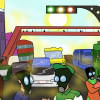Walking in the city

Sunil Gangopadhyay once authored a poem urging the then Indian premier Indira Gandhi not to visit a flood-affected Gujarat on a plane, giving a surprising excuse. He thought that seeing the image of the overturned sky reflected on the floodwater that devoured everything except for a few surviving rooftops and tall trees, Gandhi might be filled with a gush of appreciation and exclaim, "How beautiful!"
October 23 marks the 10th death anniversary of Gangopadhyay, one of the most celebrated Bangalee writers. Great writers have the gift of transcending their time and space. They invite us to join a realm of imagination where national and historic boundaries become immaterial. The limit of their language becomes a springboard to venture limitless possibilities. Revisiting the poem "To Indira Gandhi" ahead of his death anniversary reminded me of the danger of looking at reality from a safe distance. In a world where optics provided by drones are encompassing our imagination, we often learn to detach ourselves from the ground reality and find satisfaction in having a broader view of things.
"To Indira Gandhi" made me think of a fascinating essay by French philosopher Michel de Certeau. In "Walking in the City," included in his 1980 collection The Practice of Everyday Life, de Certeau contrasts his experience of seeing the city of New York from the height of the World Trade Center and walking through the city. For him, those who have the view from the top assume a power position to control what is below. In contrast, the pedestrians make their own rules in scripting their escape from the city's regulatory schemes. On Thursday, when a middle-aged woman jaywalked across Airport Road near Banani and was saved only by the auto-brake of my car, I thought of the efficacy of de Certeau's subversive proposition. For de Certeau, a pedestrian makes new meanings of the paces by redefining their assigned purpose. The one who stands in the middle of the road to hurry the bus to the spot, the one yelling at someone on their phone, the one sipping from a green coconut while standing in the middle of the footpath, the one stopping you to ask for charity, the dog taking a day nap on a footpath, the graffiti on the wall, the ads on the lampposts, the litters, the missing manhole lids, the hawkers – they all form a lived narrative that can only be reduced as a view when seen from the above. The stories come alive when you walk in the city and meet the faces that form the mass.
I thought of the middle-aged burqa-clad woman who nearly had an accident with my car. I tried to imagine her story. From the comfort of my car, am I in a position to judge her recklessness, confusion or desperation to cross the street in a city that shows no mercy to pedestrians? The negligence shown towards pedestrians in Dhaka is evident even at a policy level. The government shows no remorse in landing the stairs of the foot overbridges or metro stations in the middle of the footpaths. Local politicians and policemen have no hesitation in allowing peddlers and swingers to occupy the footpaths meant for walkers. Landlords and shop owners have no qualms over marking their territory in public space. Pedestrians are a class that can be easily ignored. They do not have the united face that appears on the poster of a trade or worker's union. With no collective representation, they move like an abstract mass treated as nothing more than a nuisance by those on wheels.

Sunil Gangopadhyay and Michel de Certeau thronged my Friday musings while thinking of the need for a skywalk to separate motorists from pedestrians to improve walkability in Dhaka city. Having lived in Manila and Bangkok for some time, I have fond memories of ambling along the skyway, also known as a sky bridge – an elevated pedway that connects two or more buildings or zones. Usually, these footbridges are covered to shelter pedestrians from the weather. In Seoul, they have created urban skyways as linear parks designed for walking or recreational purposes.
With the pillars of the metro rail standing tall all over the city, there is a new contender for the section of the road. The space for pedestrian mobility is being squeezed by the minute. With our development projects focusing on mass transit, we've forgotten one minor thing: there would be pedestrians who would have to negotiate through the pillars to reach the stations. Especially in major junctions like Shahbagh, where we will have punters of different needs going to adjacent hospitals, universities, museums, malls, hotels, and parks, we will need a network of the pedestrian platform. They can be either in the form of a skywalk or a subway. We need to make room for pedestrians and ease their walkability.
The drone view of Dhaka will indeed give a scenic picture where the metro rail and elevated roads run through it, but we need to create a space for the pedestrians, or else they will start making their own rules, which is never a good omen for any ruler.
Dr Shamsad Mortuza is a professor of English at Dhaka University.

 For all latest news, follow The Daily Star's Google News channel.
For all latest news, follow The Daily Star's Google News channel. 








Comments